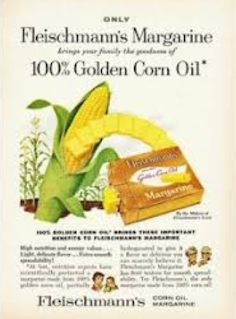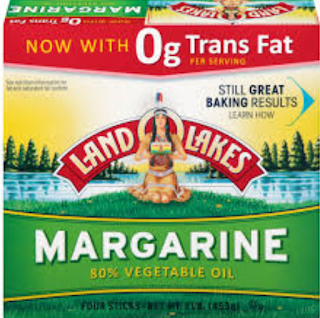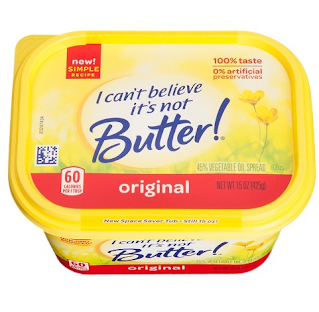The first margarine product was called "Oleomargarine." Depending on where you bought it, how it was processed and how it was displayed in the stores, the product came in various shades of yellow because it was dyed to look like real butter. It was a non-refrigerated product which also caused changes to the color and consistency.
In 1871, German pharmacist Benedict Klein founded the first margarine factory in Germany.
In 1813 French chemist Michel Eugene Chevreul discovered margaric acid, which was at that time regarded as one of the three fatty acids along with oleic acid and stearic acid. These acids form animal fats which are high in calories and are definitely not heart-healthy.
In 1853, German chemist Wilhelm Heinrich Heintz analyzed margaric acid and determined its ingredients were a combination of stearic acid and palmitic acid.
As stated in the following 1874 newspaper clipping, Oleomargarine was sold in London and Paris and has made its way to New York and Boston. There were two Oleomargarine factories in New York which together produce 19,000 pounds comes to over 23 tons per day.
 |
| Artificial butter, 1874 Vermont Journal, Springfield, Vermont. |
Some brands of Oleomargarine had liquid oil floating on the surface of the unrefrigerated tubs of Oleomargarine, a sign that it had gone rancid. Most consumers said it was hard to pinpoint exactly what was wrong with the taste of certain Oleomargarine brands, except to say that it was simply "off."
 |
| British Blend Margarine 1950's |
The Real Inventor of Margarine
Our baby boomer readers (born 1960 and later) may say that margarine first came into use in the 1970's, which is about the time when it was first noticed it in supermarkets.
Our older readers may argue that margarine first appeared during World War II, when it was offered as a replacement for real butter because of food shortages.
Both would be incorrect. Oleomargarine was first introduced in France and was created by Hippolyte Mege-Mouries, a French chemist, was well-known to Napoleon III. He was working at la Ferme Impériale de la Faisanderie, which was Napoleon III's private farm in Vincennes near Paris.
Both would be incorrect. Oleomargarine was first introduced in France and was created by Hippolyte Mege-Mouries, a French chemist, was well-known to Napoleon III. He was working at la Ferme Impériale de la Faisanderie, which was Napoleon III's private farm in Vincennes near Paris.
Formerly he worked as a pharmacist for the royally supported Hotel Dieu Hospital in Paris where he was published in medical journals, most notably, his findings of experiments that reduced the side effects of a syphilis medication.
In 1869, France was going through a butter shortage. Napoleon III wanted a cheaper but buttery-tasting product to feed the French troops, but also a product that the lower classes would be able to afford. French Emperor Napoleon III, nephew of Napoleon Bonaparte, sponsored a contest where he asked for an affordable butter substitute that was less perishable than butter. The French people hurried to get working on their creations of a butter substitute. The winner was made from beef tallow for use by the military and by the lower classes.
Hippolyte won the contest but because he was employed by Napoleon III at the time Oleomargarine was created, he had to prove he was entitled to the prize money. In 1869, Hippolyte filed a patent on his concept and expanded his French manufacturing operation.
Mege-Mouries was no stranger to obtaining patents. He held patents for effervescent tablets, for techniques in papermaking, for sugar refining, and for the tanning of leather using egg yolks.
He had been experimenting with Margaric Acid, a new fatty acid discovered in 1813 by Michel Eugene Chevreul, his former teacher. He mixed processed beef tallow with skimmed milk and created what he called "oleomargarine." As requested, it was less perishable than butter and far cheaper.
 |
| 1960's ad for Fleischmann's Margarine. |
When Mege-Mouries received his prize winnings, he expanded his manufacturing company outside of Paris. His product was exported to England and other countries. He enjoyed quite a boom market until the food shortages were over and butter manufacturers were back to enjoying high sales of their product. It was then that Mege-Mouries saw his sales suffer because the butter exports eliminated the need for people to buy Oleomargarine.
War often was a boon to businesses, especially any business having to do with food, but the Franco-Prussian War didn't help with the success of oleomargarine. For the lower classes, the French economy had its ups and downs because it was impacted by the ongoing Franco-Prussian War. Consequently, Mege-Mouries's venture to produce oleomargarine never realized great profits.
After winning the contest, Mege-Mouries got busy applying for patents to protect his process. He applied for and was granted a number of patents for the 'process of making margarine.' French patent (brevet) No. 86,480 for "production de certains corps gras d'origine animale" (translation: production of certain fats of animal origin) which was filed on July 15, 1869, and was granted on October 2, 1869. However, the French patent was only for fifteen years. After the 15 years, it was public domain, available to anyone to use or modify.
He also received quite a few foreign patents for Olegomargarine, some of which were: an English patent on July 17, 1869, one for Austria on October 31, 1869, for Bavaria on April 8, 1873, and Patent 146012 for the United States on December 30, 1873.
All seemed to be going well for Mege-Mouries until late 1869 when the Netherlands repealed its 1817 Patent Act. This meant there was no enforcement to honor patent agreements from 1869 to 1912. The Dutch did not pass a new patent act until 1910.
Without a Dutch legal framework that laid out patent rights, Mège-Mouriès could not sell his rights. He also could not apply for any more patents, establish a monopoly, or give license to others to do so in the Netherlands. Butter suppliers had been exporting large amounts of butter to England and other countries for two decades. Now, they weren't required to respect the Oleomargarine patents granted to Mège-Mouriès in other countries.
He felt forced to sell, so in 1871, he sold his French patent to a Dutch butter company owned by Antoon Jurgens. The Jurgens Company is now known as Unilever.
After winning the contest, Mege-Mouries got busy applying for patents to protect his process. He applied for and was granted a number of patents for the 'process of making margarine.' French patent (brevet) No. 86,480 for "production de certains corps gras d'origine animale" (translation: production of certain fats of animal origin) which was filed on July 15, 1869, and was granted on October 2, 1869. However, the French patent was only for fifteen years. After the 15 years, it was public domain, available to anyone to use or modify.
He also received quite a few foreign patents for Olegomargarine, some of which were: an English patent on July 17, 1869, one for Austria on October 31, 1869, for Bavaria on April 8, 1873, and Patent 146012 for the United States on December 30, 1873.
All seemed to be going well for Mege-Mouries until late 1869 when the Netherlands repealed its 1817 Patent Act. This meant there was no enforcement to honor patent agreements from 1869 to 1912. The Dutch did not pass a new patent act until 1910.
Without a Dutch legal framework that laid out patent rights, Mège-Mouriès could not sell his rights. He also could not apply for any more patents, establish a monopoly, or give license to others to do so in the Netherlands. Butter suppliers had been exporting large amounts of butter to England and other countries for two decades. Now, they weren't required to respect the Oleomargarine patents granted to Mège-Mouriès in other countries.
He felt forced to sell, so in 1871, he sold his French patent to a Dutch butter company owned by Antoon Jurgens. The Jurgens Company is now known as Unilever.
 |
| Land O Lakes was trustworthy for butter, so it was a short leap to trust their margarine |
Meanwhile, in 1871 in the United States, Henry Bradley from Binghamton, New York received a patent for "creating a margarine process that combined vegetable oil and animal fat." Other companies were still using plant substances.
Although margarine enjoyed sales in the United States, it continued to be manufactured by butter companies until the late 1950's. They wanted to earn some of the profits from margarine buyers.
Butter from cows had a yellow tinge. Oleomargarine had a white color, which made the margarine look like lard, and some consumers thought it was unappetizing. Around the late 1880s, the margarine manufacturers began adding yellow color during the processing to make the margarine look more like butter. Then sales improved.
In 1951, the W.E. Dennison Company received U.S. Patent 2,553,513 for a method to place a capsule of yellow dye inside a plastic package of margarine. After purchase, the capsule was broken inside the package, and then the package was kneaded by hand to distribute the dye. There might not be too many readers who remember that. I was a young girl then and i don't remember that.
 |
| Some kinds of margarine taste so much like butter that you can't tell the difference |
Around 1955, the artificial coloring laws were repealed. Margarine could now be legally sold with food coloring to make it look like butter. This meant the yellow dye capsule was no longer needed.
With all the hype about eating heart healthy, you might be surprised about the pros and cons of butter and margarine. The following sites might be of interest to you.
https://www.ourheritageofhealth.com/the-history-of-margarine-and-why-butter-is-better/
http://blog.fit-fresh.com/butter-vs-margarine-whats-difference/
https://bigpictureeducation.com/lovely-spread
https://wellnessmama.com/2193/never-eat-vegetable-oil/
https://www.world-foodhistory.com/2015/09/history-of-margarine.html
Please share our links with your friends so they can enjoy reading our posts too. Here is the link to this post. Thank you.
https://inventionsandpatents.blogspot.com/2019/04/oleomargarine.html
No comments:
Post a Comment